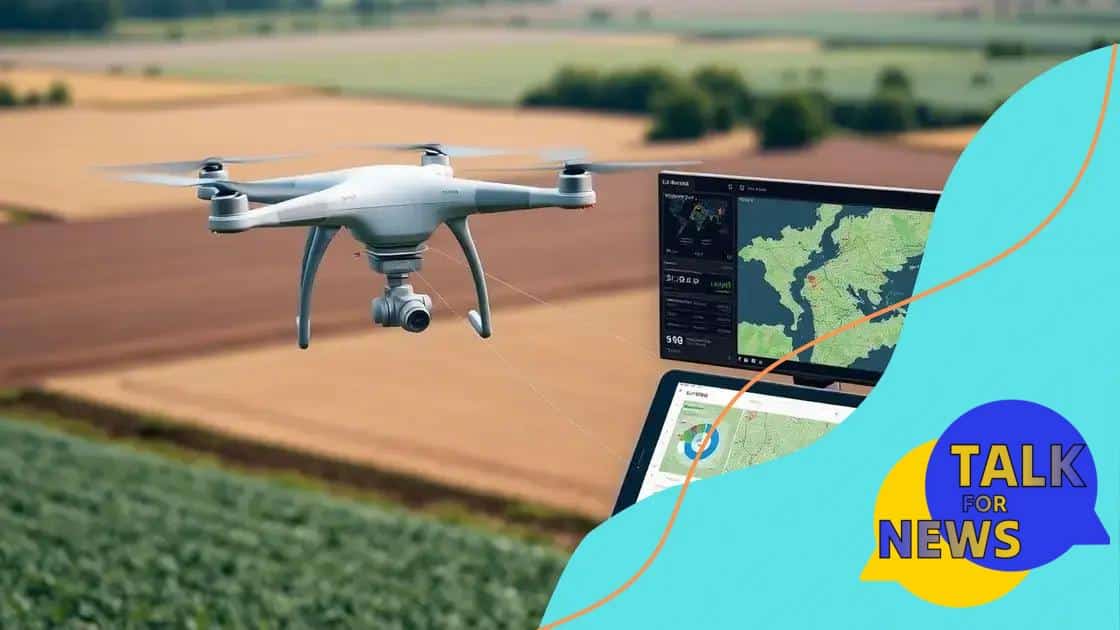How autonomous drones are reshaping global agriculture

Anúncios
Autonomous drones are reshaping global agriculture by enhancing data collection, improving crop monitoring, increasing efficiency, and supporting sustainable farming practices, leading to healthier crops and optimized resource management.
How autonomous drones are reshaping global agriculture is a question many in the farming community are pondering. These innovative technologies are not just futuristic concepts; they are becoming integral to modern farming. Curious about how they might impact your farming approach?
Anúncios
The role of drones in precision agriculture
The integration of drones in farming practices has enhanced the concept of precision agriculture, making it easier for farmers to monitor and manage their crops effectively. Drones equipped with advanced sensors collect invaluable data that can significantly improve decision-making processes.
How Drones Assist in Crop Management
By utilizing autonomous drones, farmers can optimize various aspects of crop management. These devices provide aerial views of vast fields, allowing for targeted interventions where they are most needed. For instance, drones can identify areas that require water or fertilizer.
- Real-time monitoring of crop conditions
- Identifying pest infestations early
- Assessing soil health and moisture levels
- Mapping fields for efficient planting
Anúncios
The data collected is not only crucial for immediate actions but also aids in long-term planning. A farmer can compare past data with current insights, leading to more informed decisions regarding crop rotation and resource allocation.
The use of drones also helps reduce waste, as farmers can apply inputs more precisely. Instead of treating an entire field uniformly, treatments can be localized to where they will be the most effective. This method not only saves money but also promotes sustainable practices in farming.
Benefits for Crop Yield and Quality
Another significant advantage of employing drones in precision agriculture is the potential increase in crop yield and quality. By managing resources more efficiently and responding quickly to issues, farmers can expect healthier plants and higher production rates.
Moreover, drones can conduct multispectral imaging to detect plant health, allowing for early intervention. This way, farmers can prevent loss and enhance the quality of the produce. Ultimately, the role of drones in precision agriculture streamlines farming operations and fosters a more productive and environmentally friendly approach.
As technology advances, the potential for drones in agriculture continues to grow, promising exciting developments that will further enhance the productivity and sustainability of farming.
Benefits of using autonomous drones for monitoring crops
The use of autonomous drones for monitoring crops offers numerous benefits that are transforming agricultural practices. These drones provide farmers with innovative tools that streamline operations and enhance productivity.
Enhanced Data Collection
One of the primary advantages of using drones is their ability to collect accurate data efficiently. Unlike traditional methods, drones can cover large areas quickly, providing real-time assessments of crop health. This data aids farmers in making timely decisions, optimizing resource allocation, and ensuring that plants receive the attention they need.
- Instant feedback on crop conditions
- High-resolution imagery for detailed analysis
- Ability to collect multispectral data for assessing plant health
- Reduction in labor costs and time used for monitoring
Furthermore, drones enable precision agriculture, allowing farmers to identify specific areas that require intervention. This targeted approach not only improves the efficiency of farming practices but also reduces waste and conserves resources.
Improved Crop Health and Yield
Another significant benefit of autonomous drones is their contribution to improved crop health and overall yield. By continuously monitoring crops, farmers can detect problems such as pest infestations, water stress, or nutrient deficiencies early on. This capability leads to proactive management rather than reactive measures.
Additionally, the use of drones allows for a more accurate application of fertilizers and pesticides. Farmers can apply treatments precisely where they are needed, resulting in healthier crops and minimized environmental impact.
The integration of autonomous drones into farming practices is proving to be a game changer. As technology continues to evolve, the potential for increased efficiency and sustainability in agriculture becomes even more promising.
How drones improve data collection and analysis

The use of drones in agriculture significantly enhances the way data is collected and analyzed. These high-tech devices are transforming traditional farming methods, making it easier for farmers to gather vital information about their crops and fields.
Real-time Data Acquisition
One of the key benefits of drones is their ability to collect data in real-time. Farmers can now monitor crop conditions as they change throughout the day without the need for manual inspections. This real-time data allows for quick decisions regarding irrigation, fertilization, and pest control.
- Immediate insights into crop health
- Access to comprehensive field data
- Efficient use of resources
- Reduction in the amount of time spent on manual monitoring
Additionally, drones equipped with sensors can perform multi-spectral and thermal imaging, providing farmers with detailed insights into plant health and soil conditions. This technology reveals variations within a field, helping farmers to identify stressed plants that require attention.
Advanced Analysis Tools
Beyond just data collection, drones are linked to advanced software tools that analyze the collected data. This integration enables farmers to create comprehensive maps and models of their fields. These maps can show moisture levels, nutrient distribution, and crop health, making it easier to plan appropriate interventions.
The analytical capabilities of drone technology help farmers to optimize their farming practices. By understanding how different areas of their fields perform, they can adjust their planting strategies or resource allocation to improve productivity.
Incorporating drones into farming not only streamlines data collection but also enhances the accuracy of analysis. The ability to visualize and interpret data effectively empowers farmers to make informed decisions that lead to increased yield and sustainability.
Challenges faced by autonomous drone technology
Despite the many advantages of autonomous drone technology in agriculture, there are several challenges that farmers and developers face. Understanding these obstacles is crucial for maximizing the potential of drones in farming.
Regulatory and Legal Issues
One major challenge is navigating the regulatory landscape. Laws regarding drone usage can vary widely by region and country. Farmers must ensure compliance with local regulations, which can sometimes be complex and restrictive.
- Restrictions on drone flight paths
- Licensing requirements for operators
- Privacy concerns related to aerial photography
- Airspace management and coordination with other aircraft
These legal hurdles can deter some farmers from adopting drone technology, especially those who may not have the resources to stay compliant.
Technical Limitations
Another challenge lies in the technical limitations of current drone technology. While drones are capable of capturing a wealth of data, issues such as battery life and payload capacity can affect their efficiency. For instance, the duration of flight for many drones can restrict the area that can be monitored in one session.
Additionally, harsh weather conditions can impact the performance of drones. Strong winds or rain can lead to inaccurate data collection or even damage to the equipment. Farmers need to consider these factors when planning their drone operations.
The integration of drones into existing farming practices also requires training and a learning curve for operators. Not all farmers may be familiar or comfortable with the technology, leading to inefficiencies in usage.
Data Management Challenges
Moreover, managing and analyzing the large volumes of data collected by drones poses another challenge. Farmers need access to robust software solutions to effectively interpret this data. Without proper analysis tools, the potential benefits of the data can go unutilized.
As the technology evolves, overcoming these challenges will be essential for the widespread adoption of autonomous drones in agriculture. Collaboration between farmers, technology developers, and regulators will help pave the way for a more efficient and sustainable future in farming.
The future of agriculture with drone integration
The future of agriculture is poised for a significant transformation with the integration of drones. As technology continues to evolve, farmers are increasingly adopting these innovative tools to enhance productivity and sustainability.
Autonomous Farming Systems
One promising direction is the development of fully autonomous farming systems. Drones can work alongside other automated equipment, such as tractors and harvesters, to create a seamless workflow on farms. This automation can lead to higher efficiency and reduced labor costs.
- Improved planting techniques
- Automated pest control solutions
- Streamlined irrigation management
- Enhanced crop monitoring and data collection
As drones become more sophisticated, their ability to perform complex tasks will increase, allowing farmers to focus on strategic decisions rather than day-to-day operations.
Data-Driven Decision Making
The integration of drones also supports data-driven decision-making in agriculture. Farmers can utilize the data collected by drones to analyze soil health, monitor crop growth, and predict yields. This information allows for better resource management and more precise applications of water and fertilizers.
Moreover, using advanced analytics alongside drone technology can help in crafting customized solutions for individual farms. By understanding their unique conditions, farmers can optimize their practices for improved outcomes.
Sustainability and Environmental Impact
Another exciting aspect of drone integration in agriculture is its potential to enhance sustainability. With the ability to apply inputs precisely where they are needed, drones can help reduce chemical runoff and waste. This focus on precision agriculture not only benefits farmers’ bottom lines but also contributes to healthier ecosystems.
The future of agriculture with drone integration is bright, as technology continues to advance. By embracing these innovations, farmers can unlock new levels of efficiency, sustainability, and productivity, ensuring a more secure food supply for future generations.
The future of agriculture relies heavily on the integration of drones, promising exciting advancements that can enhance productivity and sustainability. By using drones, farmers can achieve greater efficiency in their operations, make data-driven decisions, and produce healthier crops. As technology continues to evolve, the potential for drones to optimize farming practices becomes increasingly apparent. Embracing these changes will not only improve yields but also support eco-friendly farming methods, ensuring a secure food supply for generations to come. With ongoing developments, the agricultural landscape may look vastly different in the near future, showcasing innovations that work harmoniously with nature.
FAQ – Frequently Asked Questions about Drones in Agriculture
What are the main benefits of using drones in agriculture?
Drones improve data collection, enhance crop monitoring, boost efficiency, and support sustainable practices.
How do drones help with crop health monitoring?
Drones provide real-time images and data on crop conditions, helping farmers identify issues like pest infestations and water stress quickly.
What challenges do farmers face when using drone technology?
Farmers encounter regulatory hurdles, technical limitations, and the need for effective data management tools.
How does drone technology contribute to sustainable farming?
Drones allow for precise application of fertilizers and pesticides, reducing waste and environmental impact while promoting healthier ecosystems.





